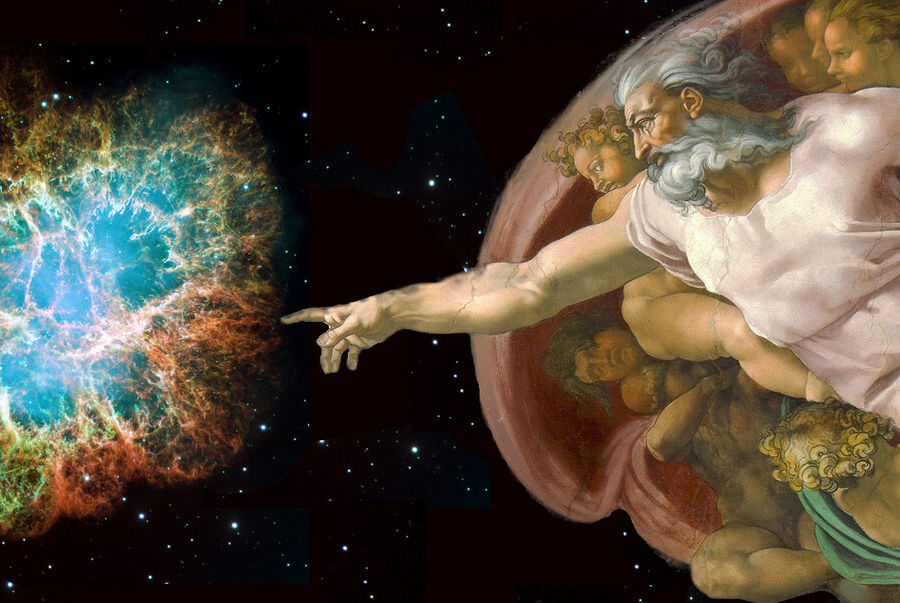Hi readers! Let’s see how science is described in Hinduism.
Hinduism is the world’s third largest religion that emerged on the Indian subcontinent between 500 BCE and 300 CE. Majority of the Hindus live in India, some in Nepal, Sri Lanka, and Southeast Asia, and in western countries especially the United States.
Contrary to Islam, Hinduism does not draw distinction between God and creation. There are beliefs that reality, the universe and the cosmos are identical with divinity, and believe that God and the world are inter-related with the world being in God and the God being in the world. Such views are also seen in Christianity, Judaism, and Islam but these are in minority positions.
Many Hindus believe in a personal God and identify this God inherent in creation. This view has ramifications for science and religion debate because there is no sharp distinction between creator and the creatures.
Religious traditions originating in the Indian subcontinent such as Hinduism, Jainism, Buddhism, and Sikhism, are referred to as dharmic religions. These religions share many similarities in core beliefs, modes of worship, and associated practices due to their common history of origin, and some mutual influences.
Hindu philosophy encompasses the world views and teachings which include six systems comprising Samkhya, Yoga, Nyaya, Vaisheshika, Mimamsa and Vedanta. In Indian tradition, the word used for philosophy is Darshana from the Sanskrit root drish.
One factor that unites different strands of Hinduism is the importance of foundational texts composed between 1600 and 700 BCE. These include the Vedas, which contain hymns and prescriptions for performing rituals, and Brāhmaṇa accompanying liturgical text (customary public ritual of worship performed by a religious group) and Upaniṣad: “student sitting on the floor near” teacher while receiving spiritual knowledge.
Vedas discuss gods who personify and symbolize natural phenomena such as fire (Agni) and wind (Vāyu). More gods appear latter in the 4th century e.g., Gaṇeśa (the remover of obstacles and the offspring of Shiva: the Hindu god of destruction and his partner the goddess Parvati. Several myths designate his birth and getting hold of the elephant head). There are Hindus who worship more than one god and those who worship only one god hence it is not the case that an individual believer worship all of these gods.
Ancient Vedic rituals encouraged knowledge of diverse sciences, including astronomy, linguistics, and mathematics. Astronomical knowledge was required to determine the timing of rituals and the construction of sacrificial platforms. Linguistics developed to formalize grammatical rules for classical Sanskrit used in rituals.
Large public offerings required the construction of intricate/decorative platforms which posed geometrical problems which led to advances in geometry.
Classic Vedic texts frequently used very large numbers to denote the age of humanity and the Earth which required a system to represent numbers economically giving rise to a 10-base positional system the “decimal” system, that requires a total of ten different digits like 0, 1, 2, . . . 9 to write any number. The decimal system is also an example of a positional base system, which means that the position of a digit gives its place value and a symbolic representation for zero as a placeholder. In this way, ancient Indian dharma encouraged the emergence of the sciences.
However, the northern part of the Indian subcontinent experienced an extensive urbanization around sixth and fifth century BCE during which medicine (āyurveda) became standardized. Wide range of untraditional philosophical schools emerged during this period including Buddhism, Jainism, and Cārvāka: a form of metaphysical naturalism that deny the existence of gods or karma.
Karma is a force generated by a person’s actions that is continuously travelling and determine the nature of the person’s next existence. According to Hindu and Buddhism,
each individual is born with karma or the sum of a person’s actions
in this and previous existence that is viewed as deciding factor in their fate in future existences.
The relationship between science and religion on the Indian subcontinent is complex, in part because the dharmic religions and philosophical schools are different. For example, Cārvāka: an ancient school of Indian materialism also known as Lokāyata, holds direct perception, experimentation, and conditional inferences as proper sources of knowledge and rejects ritualism and supernaturalism.
Natural theology also flourished in the pre-colonial period, especially in the Advaita and Vedānta: a darśana that identifies the self ātman (a non-material self, which never changes. It is distinct from both the mind and the external body. This real self is beyond ego, mind and personified existence), with ultimate reality: the Brahman. Vedanta reflects ideas that emerged from, or were aligned with, the speculations and philosophies contained in the Upanishads, specifically, knowledge and liberation.
According to Vedanta, God is of infinite existence, of infinite consciousness, and of infinite delight. The term for this impersonal, transcendent reality (which is beyond or above the range of normal or physical human experience) is Brahman, the divine ground of being. Nevertheless, Vedanta also maintains that god can be personal as well as can assume human form in every age.
Adi Śaṅkara was an author who regarded Brahman as the only reality and cause of the universe (meaning thereby that the Universe was created for Brahmans). Śaṅkara formulated design and cosmological arguments drawing on analogies between the world and artifacts (something observed in a scientific investigation or experiment that is not naturally present but occurs as a result of the preparative or investigative procedure). He says, that “in ordinary life, we never see non-intelligent agents or forces (Gravitational force, weak nuclear force, electromagnetic force and strong nuclear force) producing goal-oriented designs, yet the universe is suitable for human life just like benches and pleasure gardens are designed for us. Since, the universe is complex to the extent that even an intelligent craftsman cannot comprehend it, how could it have been created by non-intelligent natural forces”? Śaṅkara concluded that it must have been designed by an intelligent creator.
From 1757 to 1947, India was under British colonial rule. This had a profound influence on its culture as Hindus came into contact with western science and technology. For local intellectuals, the contact with western science presented a challenge: how to assimilate these ideas with Hinduism? Mahendrahal Sircar (1833–1904) was one of the first authors to examine evolutionary theory and its implications for Hindu religious beliefs. Sircar was an evolutionary theist, who believed that God used evolution to create current life forms. While Sircar accepted organic evolution through common descent, he questioned the mechanism of natural selection as it was not explaining the phenomena in terms of the purpose, they serve rather than the cause by which they arise which went against his evolutionary theism. This was a widespread problem for the acceptance of evolutionary theory: one that Christian evolutionary theists also struggled with. He also argued against the British colonist’s beliefs that Hindus were incapable of scientific thought, and encouraged fellow Hindus to engage in science, which he hoped would help regenerate the Indian nation.
The assimilation of western culture prompted various revivalist movements that sought to reaffirm the cultural value of Hinduism. They put forward the idea of a Vedic science, where all scientific findings are already prefigured in the Vedas and other ancient texts. This idea is still popular within modern Hinduism and is quite similar to the ideas held by modern Muslims, who refer to the Qurʾān as a harbinger of scientific theories.
Responses to evolutionary theory ranges between denial based on a perceived mismatch with Vedic texts and acceptance. Dayananda Saraswati (1930–2015) rejected evolutionary theory whereas Vivekananda (1863–1902), willingly endorsed it arguing that it is already prefigured in ancient Vedic texts. His integrative view claimed that Hinduism and science are in harmony. Sri Aurobindo Ghose, a yogi and Indian nationalist who was educated in the West, formulated a synthesis of evolutionary thought and Hinduism. He interpreted the classic avatara doctrine: a Sanskrit term which means “descent” or an act of moving downwards, dropping, or falling. It signifies the material appearance or personification of a powerful deity according to which God personify into the world repeatedly throughout time, in evolutionary terms.
God thus appears first as an animal, later as a dwarf, then as a violent man (Rama), and then as Buddha, and as Kṛṣṇa or Krisna.
He proposed a hypothetical picture where both spiritual evolution and physical evolution are ultimately the display of God (Brahman).
During twentieth century, Indian scientists began to gain prominence. C.V. Raman (1888–1970): a Nobel Prize winner in physics, and Satyendra Nath Bose (1894–1974), a theoretical physicist described the behavior of photons statistically and gave his name to bosons (a subatomic particle whose spin quantum number has an integer value). However, these authors were silent on the relationship between their scientific work and their religious beliefs.
Contrary to this, mathematician Srinivasa Ramanujan (1887–1920) was open about his religious beliefs and their influence on his mathematical work. He claimed that the goddess Namagiri helped him to intuit (work out by instinct.) solutions to mathematical problems. Similarly, Jagadish Chandra Bose (1858–1937), a theoretical physicist, biologist, biophysicist, botanist, and archaeologist who worked on radio waves, saw the Hindu idea of unity reflected in the study of nature. He started the Bose institute in Kolkata in 1917, the earliest interdisciplinary scientific institute in India.
That is how science originated in Hinduism dear readers. Hope you will enjoy reading this blog PLEASE LIKE IT IF YOU DO.
See you next week
Bye.





